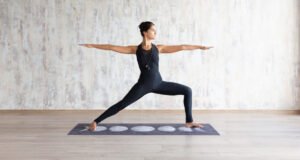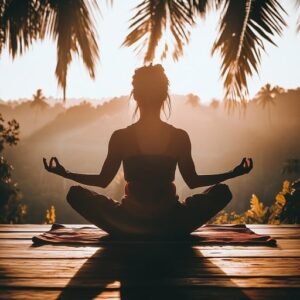In today’s fast-moving world,many people are turning to Yoga for Strength, Balance, and Peace in 2025. Transform Your Mind & Body as a way to not only to improve physical fitness but also their emotional resilience and inner calm.This timeless practice continues to evolve,offering the perfect combination of
strength, balance, and peace.
This ancient practice goes far beyond physical exercise. It transforms how we move, breathe, and think, creating harmony between body, mind, and soul. As we step into 2025, the benefits of yoga feel more relevant than ever. Let’s explore how yoga builds strength, restores balance, and brings lasting peace — both on and off the mat.
Strength: More Than Just Muscles
 When we think of strength, most imagine lifting weights or building toned muscles. Yoga teaches us that real strength is both physical and mental.– Physical strength: Poses like Plank, Warrior II, and Chair Pose build muscle naturally. Unlike heavy workouts, yoga strengthens while protecting joints.– Mental strength: Holding challenging postures trains focus and patience.– Emotional resilience: Just as we hold difficult poses with steady breath, we learn to hold difficult emotions with calmness.👉 Related Post: 5 Morning Stretches for Glowing Skin and All-Day Energy (https://fitnessfreak.blog/5-morning-stretches-for-glowing-skin-and-all-day-energy/)
When we think of strength, most imagine lifting weights or building toned muscles. Yoga teaches us that real strength is both physical and mental.– Physical strength: Poses like Plank, Warrior II, and Chair Pose build muscle naturally. Unlike heavy workouts, yoga strengthens while protecting joints.– Mental strength: Holding challenging postures trains focus and patience.– Emotional resilience: Just as we hold difficult poses with steady breath, we learn to hold difficult emotions with calmness.👉 Related Post: 5 Morning Stretches for Glowing Skin and All-Day Energy (https://fitnessfreak.blog/5-morning-stretches-for-glowing-skin-and-all-day-energy/)
Balance: Stability for Body and Life

Yoga’s balancing postures like Tree Pose and Eagle Pose do more than improve posture — they teach life balance.
– Physical balance: Improves posture, coordination, and body awareness.
– Lifestyle balance: Teaches when to push forward and when to slow down.
– Inner balance: Breathwork and meditation guide us back to our center.
For more science-backed insights, check this article from Harvard Health on yoga’s benefits (https://www.health.harvard.edu/mind-and-mood/the-health-benefits-of-yoga).
Peace: The Ultimate Gift of Yoga
Image Suggestion: Meditation Yoga – Pixabay
ALT text: Person meditating at sunrise for inner peace
Perhaps the most profound gift of yoga is peace of mind. Slow breathing lowers stress hormones and creates mental stillness.
– Calms the nervous system.
– Quietens racing thoughts.
– Builds “witness consciousness” — the ability to observe emotions without being controlled by them.
Yoga’s calming effects are well-documented by Mayo Clinic – Yoga for Stress Relief (https://www.mayoclinic.org/healthy-lifestyle/stress-management/in-depth/yoga/art-20044733).
How Strength, Balance, and Peace Work Together
What makes yoga powerful is how these three gifts are interconnected. Physical strength builds emotional resilience. Balance in movement supports balance in life. Together, they create the foundation for long-term peace.
With regular practice, yoga stops being just an exercise and becomes a lifestyle — one that supports health, confidence, and inner harmony.
Practical Tips to Start Yoga in 2025
Image Suggestion: Yoga Setup – Unsplash
ALT text: Yoga mat and water bottle setup at home for beginners
If you’re new to yoga or returning after a break, here are simple ways to begin:
1. Start small: Even 10 minutes a day makes a difference.
2. Try online classes or apps: Great for beginners who can’t attend studios.
3. Focus on breathing: Pair each movement with mindful breath.
4. Use beginner poses: Child’s Pose, Cat-Cow, Downward Dog, and Mountain Pose.
5. Be patient: Yoga is about progress, not perfection.
FAQs About Yoga for Strength, Balance, and Peace
- Is yoga enough to build strength without going to the gym?
Yes. Yoga uses body weight to build functional strength, especially in the core, arms, and legs.2. How often should beginners practice yoga?
Start with 2–3 sessions per week. Increase gradually to daily practice.3. Can yoga really reduce stress and anxiety?
Absolutely. Research shows yoga lowers cortisol (the stress hormone) and improves mood.4. Do I need to be flexible to start yoga?
Not at all. Flexibility develops naturally with practice.5. What type of yoga is best for beginners in 2025?
Hatha and Vinyasa yoga are ideal starting points, offering simple poses and breathing techniques.
Final Thoughts
As we enter 2025, yoga offers more than just fitness. It strengthens the body, restores balance, and cultivates peace of mind. Whether you’re a complete beginner or restarting after a break, yoga invites you to begin exactly where you are.
The gifts of strength, balance, and peace are timeless — and they’re waiting for you on the mat. Start your journey today and let yoga guide you toward a healthier, calmer, and more fulfilling life.
